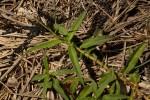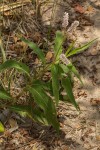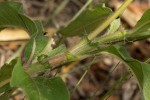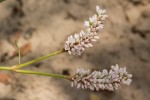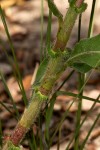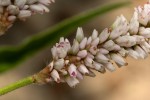Persicaria limbata
Selected images: Click on each image to see a larger version and details of the record View all images (9)
Detailed records: Display species records QDS maps by: Google Maps Point records by Google Maps
Species details: Click on each item to see an explanation of that item (Note: opens a new window)
| Synonyms: |
Polygonum limbatum Meisn. |
| Common names: | |
| Frequency: | |
| Status: | Native |
| Description: |
Erect or procumbent perennial herb, often mat-forming. Stems hollow, striate along the length, usually hairy. Distinct bract-like ocrea at the nodes, spreading or recurved at the apex; margins ciliate. Leaves linear-lanceolate, pubescent or silky hairy on both surfaces, ciliate at the base, clasping the stems. Flowers in terminal or lateral, spike-like racemes, pinkish white; peduncles hairy. Fruit a small, smooth and shiny nut, reddish-brown to black. |
| Type location: |
Syntypes from Senegal and Nile Delta |
| Notes: | |
| Derivation of specific name: | limbata: bordered, with a margin or fringe (a reference to the ocrea) |
| Habitat: | In wet habitats, at the edges of streams and dams and in moist grassland |
| Altitude range: (metres) | |
| Flowering time: | |
| Worldwide distribution: | Widespread in tropical Africa, South Africa, Egypt and India. |
| FZ divisions: | N,SW,SE |
| Growth form(s): | |
| Endemic status: | |
| Red data list status: | |
| Insects associated with this species: | |
| Spot characters: | Display spot characters for this species |
| Literature: |
Heath, A. & Heath, R. (2009). Field Guide to the Plants of Northern Botswana including the Okavango Delta Kew Publishing Page 187. (Includes a picture). Kirby, G. (2013). Wild Flowers of Southeast Botswana Struik Nature, Cape Town South Africa Page 292. (Includes a picture). Mapaura, A. & Timberlake, J. (eds) (2004). A checklist of Zimbabwean vascular plants Southern African Botanical Diversity Network Report No. 33 Sabonet, Pretoria and Harare Page 68. Nogueira, I., Ortiz, S. & Paiva, J.A.R. (2006). Polygonaceae Flora Zambesiaca 9(3) Pages 15 - 17. (Includes a picture). Ntore, S. & al. (2024). Checklist of the vascular plants of Burundi Page 212. Setshogo, M.P. (2005). Preliminary checklist of the plants of Botswana. Sabonet Report no. 37. Sabonet, Pretoria and Gaborone Page 93. |
Other sources of information about Persicaria limbata:
Our websites:
Flora of Burundi: Persicaria limbataFlora of Caprivi: Persicaria limbata
Flora of Malawi: Persicaria limbata
Flora of Mozambique: Persicaria limbata
Flora of Zambia: Persicaria limbata
Flora of Zimbabwe: Persicaria limbata
External websites:
African Plants: A Photo Guide (Senckenberg): Persicaria limbataAfrican Plant Database: Persicaria limbata
BHL (Biodiversity Heritage Library): Persicaria limbata
EOL (Encyclopedia of Life): Persicaria limbata
GBIF (Global Biodiversity Information Facility): Persicaria limbata
Google: Web - Images - Scholar
iNaturalist: Persicaria limbata
IPNI (International Plant Names Index): Persicaria limbata
JSTOR Plant Science: Persicaria limbata
Mansfeld World Database of Agricultural and Horticultural Crops: Persicaria limbata
Plants of the World Online: Persicaria limbata
Tropicos: Persicaria limbata
Wikipedia: Persicaria limbata


